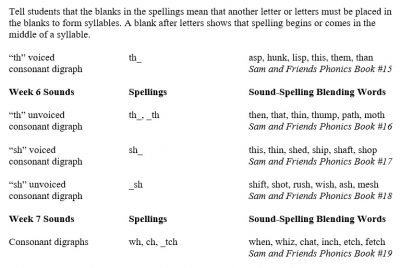r-controlled Vowels for Big Kids
Although r, l, and w do control (change from the usual) the vowel sounds, most phonics programs only include the r-controlled vowels. I agree with this approach. Try watching an l-controlled or w-controlled video lesson on YouTube and your head will start spinning. Much better to include the l-controlled vowels in the context of other sounds, such as the /aw/ diphthong for “al” and “all” and the schwa for the “_le” word parts. The w-controlled vowels are so crazy that they are most-easily learned as outlaw words (sight words). I do recommend showing two w-controlled vowels patterns via spelling sorts: the war /or/ as in warm and the wor /er/ as in word. Most speech therapists agree with this balanced approach, and they are the sounds experts.
Following is the explicit, systematic approach to phonics acquisition via small group workshops from my reading intervention program. Download the entire set of r-controlled vowel lessons and assessment at the end of the article. Plus, get the complete set of FREE diagnostic 13 reading assessments to see which of your BIG KIDS need help with which phonics elements.
How to Teach r-Controlled Vowels
Introductory Definition: When an r follows a vowel, the r changes the sound that the vowel makes. The vowel is called an r-controlled vowel. Sometimes teachers refer to the r as the “bossy r” because the r “bosses” the vowel to make the vowel change its sound.
On our animal sound-spelling cards, the names of each card: ermine, armadillo, and orca each have an r which controls the vowel sounds. Examples: /er/ as in her, /ar/ as in car, and /or/ as in for. The /er/ ermine has three different spellings, which can appear at the beginning, middle, or end of a syllable.
Teaching Tips
To teach phonics to big kids and adults, we have to teach differently than when we teach phonics to beginning readers. Your big kids and adults are smarter and have more life experience than pre-K, kinder, or first graders. They can catch on quickly if taught properly. Intervention students have “heard it all before.” They just haven’t learned all of it.
I suggest a four-pronged approach to teaching r-controlled vowels to your reading intervention students:
1. Use the animal sound-spelling cards (provided for you in a FREE five-lesson long vowels download at the end of this article) to teach the names, sounds, and spellings in isolation.
2. Teach whole-class sound-by-sound spelling blending for all of the r-controlled vowel spellings. Use a hurried pace, but blend every day until each has been mastered. Reinforce with games, using the diphthong cards to blend with the consonant and consonant blend cards.
3. Diagnose and gap-fill. If we use effective, comprehensive diagnostic assessments to determine what students know and don’t know and target instruction accordingly, students will much more likely buy-in to this individualized instruction (even when you use groups). Want my FREE 13 reading assessments, used by hundreds (or more) teachers to teach assessment-based gap-filling? BTW… the two phonics tests have audio files dictated by Yours Truly!
4. Use targeted practice to do the gap-filling and make sure your students have mastered the diphthongs through formative assessment. The FREE five-lesson download includes a short formative assessment. Be willing and able to re-teach if they don’t get it. After all, reading intervention is all about learning, not teaching.
Get the The r-controlled Vowels Lessons and Assessment FREE Resource:
![]()
Or… why not buy all the phonics lessons and more?

The Science of Reading Intervention Program
The Science of Reading Intervention Program: Word Recognition includes explicit, scripted instruction and practice with the 5 Daily Google Slide Activities every reading intervention student needs: 1. Phonemic Awareness and Morphology 2. Blending, Segmenting, and Spelling 3. Sounds and Spellings (including handwriting) 4. Heart Words Practice 5. Sam and Friends Phonics Books (decodables). Plus, digital and printable sound wall cards and speech articulation songs. Print versions are available for all activities. First Half of the Year Program (55 minutes-per-day, 18 weeks)
The Science of Reading Intervention Program: Language Comprehension resources are designed for students who have completed the word recognition program or have demonstrated basic mastery of the alphabetic code and can read with some degree of fluency. The program features the 5 Weekly Language Comprehension Activities: 1. Background Knowledge Mentor Texts 2. Academic Language, Greek and Latin Morphology, Figures of Speech, Connotations, Multiple Meaning Words 3. Syntax in Reading 4. Reading Comprehension Strategies 5. Literacy Knowledge (Narrative and Expository). Second Half of the Year Program (30 minutes-per-day, 18 weeks)
The Science of Reading Intervention Program: Assessment-based Instruction provides diagnostically-based “second chance” instructional resources. The program includes 13 comprehensive assessments and matching instructional resources to fill in the yet-to-be-mastered gaps in phonemic awareness, alphabetic awareness, phonics, fluency (with YouTube modeled readings), Heart Words and Phonics Games, spelling patterns, grammar, usage, and mechanics, syllabication and morphology, executive function shills. Second Half of the Year Program (25 minutes-per-day, 18 weeks)
The Science of Reading Intervention Program BUNDLE includes all 3 program components for the comprehensive, state-of-the-art (and science) grades 4-adult full-year program. Scripted, easy-to-teach, no prep, no need for time-consuming (albeit valuable) LETRS training or O-G certification… Learn as you teach and get results NOW for your students. Print to speech with plenty of speech to print instructional components.
Get the SCRIP Comprehension Strategies FREE Resource:
![]()
Get the Diagnostic ELA and Reading Assessments FREE Resource:












